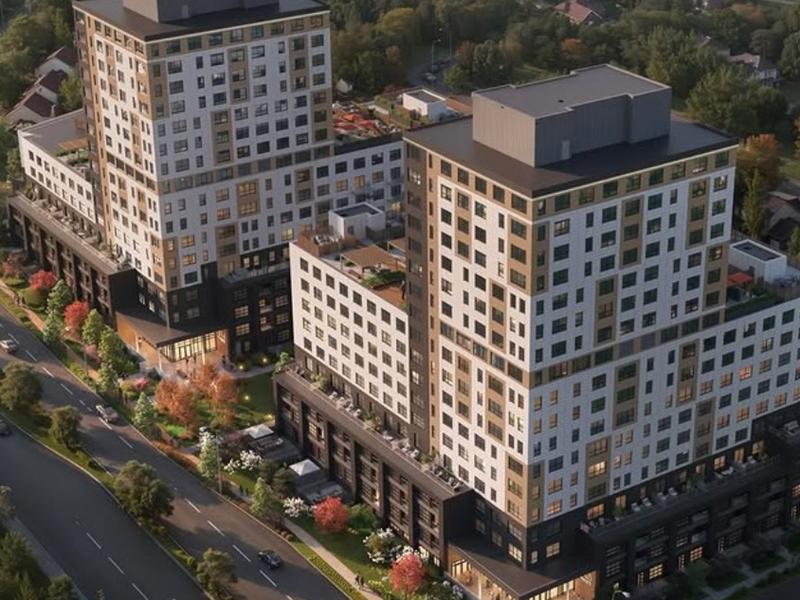One’s stuck in recessionary hell, the biggest “looks like it could be over-built” and the third looks more or less well-balanced.
 That’s the quick snapshot of the office markets of Calgary, Toronto and Vancouver respectively, that were the focus of a panel discussion at this week’s Land & Development conference held in Toronto.
That’s the quick snapshot of the office markets of Calgary, Toronto and Vancouver respectively, that were the focus of a panel discussion at this week’s Land & Development conference held in Toronto.
The trio of markets, which are expected to add an additional 11 million square feet of new product to the Canadian market over the near term, are distinctly different, have taken unique development paths in recent times and face futures that range from pessimistic to worrisome to benign.
Office vacancies are moderately rising in Vancouver due to “a supply side story” as new towers come online which is a positive story, explained Michael Caplice, executive managing director, of national operations and corporate development at Cushman & Wakefield Ltd. and moderator of the office panel.
A double whammy for Calgary
Calgary, in full meltdown mode since the cratering of world energy prices, faces a double whammy of shrinking demand for space while millions of square feet come online as new buildings are constructed.
“Calgary is a demand and supply story with demand imploding, bringing about 3.4 million square feet of negative absorption to the market in the past six months,” said Caplice.
“In addition, it has a significant amount of development arriving and much more of that product is still in the pipeline.” (About 3.9 million sq. ft. over the next 18 months, he later said.)
Toronto on the other hand, the country’s largest office market, “seems to not to want to see vacancy rise. This is about an explosive demand response whenever new supply comes on.”
Downtown Toronto numbers are amazing
Caplice noted both Toronto and Calgary enjoyed back-to-back development cycles which bookended the financial crisis of 2008-09. The buildings from those construction booms are evident now at the top end of the market in the form of premium office space.
In Toronto, a further 5.3 million square feet of premium office space is still to come online. Future growth in high end office space is really just the tip of the spear.
“If ’09 through ’19 is included, then downtown Toronto’s premium inventory growth would be greater than 27% which is just staggering,” said Caplice.
Vancouver has added 2.5 million of new downtown office space – “that’s the most significant development boom they have had in 25 years.”
Cowtown vs Lotusland
Vice-president of development Hugh Clark noted Allied Properties REIT (AP.UN-T) has “made our bet” in the Calgary market with its ongoing development of the TELUS Sky project which is a joint venture with TELUS and Westbank Corp..
The risk of that development is lessened not only by its JV character, but also by the fact 275,000 square feet is residential and TELUS has pledged to lease about 155,000 of the 430,000 sq. ft. of available office space.
“We have maintained that for the long run the project is going to be a fairly healthy return for us,” Clark said, adding the partners could have stopped development but decided to proceed.
“That one we are going to keep going but we are probably not going to start any new ones.”
As for Vancouver, “there really just isn’t the opportunity,” for development for Allied. “It is very difficult to accumulate any sites of any magnitude.”
HOOPP likes Vancouver office market
It is a different story for the Healthcare of Ontario Pension Plan (HOOPP) which is steering a “very wide berth” from the Calgary market but likes Vancouver’s office market for its “balanced state” following a major development cycle, said Nick Macrae, senior portfolio manager, real estate.
“Two of the themes that are pushing demand are capital demand in terms of accessing high-quality real estate and developing an option and secondly the changing needs of users,” said Macrae.
“In a market where there might be vacancy in existing stock or older stock, there is still demand by tenants for new stock and they are willing to pay a premium to get it.”
Sandy McNair, data curator with Altus Data Solutions, added Vancouver will continue to see new office development after “a really long drought” of 15 years prior to the recent building spate.
As for Calgary, the notoriously cyclical market faces a long down cycle as opposed to its signature fast rebound.
“This is going to be much more an `82 where it goes on for years,” McNair said.
Overbuilt or just right?
Is Toronto potentially overbuilt, as Cushman’s Caplice suggested? “That depends (on) if you are a developer or a building owner,” said HOOPP’s Macrae.
Leasing of new buildings has been “very strong,” which is good news for developers, but bad news for some class A building owners generally.
“I think we are not overbuilding in Toronto yet,” added Allied’s Clark. “One thing that is lucky is there are not a lot of cowboys in Toronto. There are a lot of well-positioned land owners who have the ability to develop but have no intention of building on spec.”
Altus’ McNair said the question of overbuilding in downtown Toronto is more nuanced and has produced “some pretty significant pockets of pain.”
In particular, “the unintended donors” of office space, the older top of markets (such as bank towers) that have lost tenants to the newly built towers.
“The A’s downtown are feeling much more stressed than the B’s are,” he said. “That might not be what most people would perceive to be the case because there is this theory that as the A’s get hurt the B’s get clobbered. We are not really seeing that, certainly not in Vancouver and I think that is not really happening in Toronto as well.
“I think the population of tenants that can occupy those A buildings that were the donors is much smaller than people think.”







